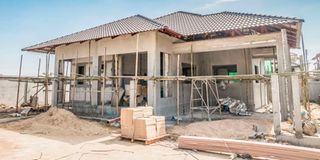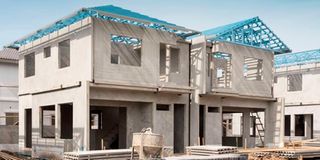Premium
Looking for potential location to invest? Consider Ruiru and it’s environs

Utawala Junction along the Eastern Bypass as pictured on November 9, 2021. The road connects Mombasa Road to Ruiru town.
What you need to know:
- This once sleepy town has been experiencing a burst of growth in the last few years.
- The town blossomed following improved infrastructure, led by a good road network.
Slightly over a decade ago, Ruiru town was nothing but a sleepy neighbourhood punctuated with old colonial homes and unremarkable commercial buildings around the town. With traffic snarl-ups on the old Thika Road snaking all the way from town to Roysambu and beyond, few would have considered working or even living near Ruiru.
But in 2009, construction of the Thika Superhighway was initiated, and by the time it was completed in 2014, Ruiru and its environs began to roar to life. But that was not all, construction of the 32km Eastern Bypass and the 21km Northern Bypass was also ongoing, though overshadowed by the superhighway.
The Eastern Bypass would connect the Kiambu-Ruiru Road to Thika Road and eventually to Mombasa Road, while the Northern Bypass connected Ruiru to Ruaka neighbourhood, along Limuru Road. The two roads plus the highway led to a growth spurt for the once sleepy town.
It is often said that roads are like arteries, through which the economy pulsates - this captures the reality of Ruiru’s case. The two bypass highways and the Thika Superhighway made the small town easily accessible from multiple towns (big and small), such as Murang’a, Garissa, Mwingi, Kitui, Nairobi, Machakos, Limuru, the JKIA, Kangundo, Naivasha, Gatundu, Thika and Kiambu.
With such accessibility, today Ruiru town is a hive of manufacturing industries, higher learning institutions, gated communities, entertainment joints and a thriving rental market. Notably, Ruiru and its environs, like Juja and Kenyatta Road, have attracted a good number of investors in the construction and real estate industries.
And those who’ve already invested in these locations say it is just the beginning. The best is yet to come. Kinyanjui Gitau, the Managing Director, Willstone Homes, a real estate company that has put up six projects along Kenyatta Road so far, says their first project along the area was purely out of demand.
“Our initial projects were located along Kangundo Road. We were looking for something metropolitan and we constructed the first estate with 49 homes. That was early 2019. We later delivered two other estates. After the third estate, people started inquiring on projects along Thika Road,” recalls Gitau.
With increasing demand, the team set out to look for a suitable location along Thika Road in 2019. At the time, there was hype for Kenyatta Road and buyers were really interested in settling here. Perhaps it was the name, which is associated with the country’s first and fourth presidents, epitomising prestige and success. Or maybe it was the location’s strategic position, not too far from the highway, yet tucked away in a serene, exclusive neighbourhood with a cool climate and beautiful scenery.
The Homeowner
“Coincidentally, there were many projects coming up, such as the Mama Ngina University and the proposed museum around Gatundu area. Kenyatta Road was also tarmacked, making the location accessible,” says Gitau, noting that these are some of the factors that made the estates along Kenyatta Road attractive to prospective buyers, hence they broke ground in 2019, offering three bedroom-bungalows with DSQs.
Surprisingly, buyers along Thika road demanded a bit more prestige. Some wanted their homes to sit on larger chunks of land, rather than the provided 1/8 acres. Others wanted spacious homes. And the most interesting bit was the diversity of those who settled around the location. Gitau notes their homes attracted buyers aged 23 and upwards.
Some were young families, others were senior citizens. This diversity is mostly attributed to accessibility and the metropolitan nature of the location. Gitau explains that people do not want to live in a neighbourhood inhabited by one tribe due to the history of post-election violence. They prefer to live in areas with diversity.

Three years ago, bungalows were selling at 5.5 million in Kenyatta Road and Ruiru. Today the same property can easily fetch a profit of Sh4 million.
From an investment angle, Kenyatta Road and Ruiru at large made a lot of sense for buyers. Three years ago, the bungalows were selling at 5.5 million. Today the same property can easily fetch a profit of Sh4 million.
“Lately there is phobia for off-plan projects, so developers have to sell at subsidised prices. By the completion date, the value has increased. Considering that developers choose locations with proposed or ongoing construction of infrastructure or amenities, completion of such boost the value immensely,” explains Gitau.
In Kenyatta Road’s case, a lot has changed in the last three years. Recreational centres, for instance, have come up to cater to the growing list of homeowners in the location. Hotels, prestigious schools, universities, road expansions, new gated communities and even the Ruiru Golf club have boosted the location’s image, elevating it to a prestigious level, thus increasing property values.
The newly earned prestige is also pushing middle upper-class families and individuals to the location in search of rental properties. If one was to put the 3-bedroom bungalow in the rental market as a furnished property, it can earn up to 60,000 per month, a figure that mirrors rental prices in established markets. People are simply willing to pay more for serenity.
While many would wonder whether Ruiru and its environs were just ‘lucky’ to attract so much growth, it would seem Ruiru was planned to be big all along, only that people rushed to develop the place before the proposed infrastructure. Gitau believes that in terms of infrastructure, a lot is still in the works. Roads are being expanded and amenities are still coming up, which means property values are bound to increase. It is likely that prospective buyers still speculating will be priced out of the prime Ruiru markets.
While this might be discouraging to such buyers, it also means that nearby locations are opening up. Juja farm, for instance, has attracted many buyers, thanks to Ruiru. Developed locations tend to ‘birth’ new developments and it goes on and on. Development is slowly spilling over and Ruiru is setting the pace.
In fact, the current Kiambu government had a vision to turn Ruiru into a city. Gitau believes that for this vision to be actualised the stakeholders have to think of Ruiru as a devolved unit, adding that in a few years’ time, it should be normal to live and conduct business in Ruiru.
Commercial Perspective
Speaking of business, Kidani Steel Mills Limited, a company that manufactures steel and profile roofing products, is one of the companies that found Ruiru a suitable business location. After the moratorium on forest logging in 2018, wood became an unavailable and expensive construction material, therefore increasing the demand for steel. In addition, the year 2020 saw a boom in the construction industry, creating a high demand for construction materials.
“The pandemic was a wakeup call to many people. They realised that the security of a job or a business is never guaranteed, so it was wise to construct if one has a piece of land somewhere,” says Lilian Kahaki, the Factory Manager at Kidani.
The company sought to supply the thirsty construction industry with steel and roofing products. While construction was ongoing everywhere, some locations such as Kangundo Road, Juja and the Eastern bypass had increased activity. Essentially, construction was moving out of Nairobi into the metropolitan locations, therefore, besides targeting builders, Kidani also needed to operate from a strategic location where they could deliver products within the shortest time possible. Ruiru, especially the bypass where Kidani is located, is connected to various locations. With the high cost of fuel, operating from an accessible location is an added advantage for any business.

Pricey rental market has discouraged many potential tenants, whether schooling or working, from living in Ruiru.
“Before we found this location, we had moved all over the place looking for the perfect place to set up. We were looking for an ideal location that would allow us to profile, produce, load and deliver products. We were also looking for accessibility. One of the things that attracted us to this location was the numerous companies within the construction industry. From cement to steel, hardware and other mabati companies. It is the perfect one-stop shop for construction supplies,” says Kahaki.
Running a business from a location with multiple businesses within the same industry might seem like inviting unnecessary competition, but that is exactly what a thriving economy needs. Perhaps Ruiru has grown into an industrial hub due to the stiff competition. Competitors compel one another to improve service delivery and customer satisfaction. Kahaki notes that good road networks are not enough to sustain a business in such an environment.
“You also need good quality products and keeping your word to the customer to stay afloat,” she says.
A good professional production and logistics team also helps to meet deadlines. Communication is also important, especially when it comes to delivering orders. The customer needs to know when their order leaves the factory and progress along the way, so they may plan their work accordingly on site.
Such centralised industrialisation creates job opportunities. Kidani, for instance, has employers in various departments, such as production, sales, logistics and marketing. The workforce translates to a high supply of tenants for the rental market. Unfortunately, Kahaki explains that there is still a big gap in the rental properties market as they do not cater for the working class in Ruiru.
“If you have a family, the properties are not accommodative. The units are not spacious enough though the singles are well catered for,” she says, adding that cost is also a put off as rental units are too pricey.
When the highways were constructed, properties along Ruiru were hyped and perhaps due to lack of guidelines and measures to streamline the property market, people began to overprice without necessarily considering the factors that affect a unit’s value.
These concerns could possibly lead to property values stagnating over time if not checked. For the rental market to thrive, there needs to be a balance between quality, price and market needs. The pricey rental market has discouraged many potential tenants, whether schooling or working, from living in Ruiru, but it is also an opportunity for those who own properties within the area. With so many companies, schools and recreational facilities, there is an undeniably high demand for housing, however, developers need to build properties that cater to the needs of these demographics.
Despite the slight miscalculations in the rental market, Kahaki agrees with Gitau that the future of Ruiru and its environs is still very bright. Currently, the expansion of the Eastern bypass into a dual carriage is ongoing.
“The bypass attracted lots of people subsequently, leading to traffic snarl-ups, but the expansion will ease this. There is also a new road that connects this bypass to Githurai,” says Kahaki.
These developments are slowly propelling Ruiru into a devolved unit. Her opinion is that the vision for Ruiru needs to take a futuristic approach. Growth needs to be all-round. If the county government can adapt a long-term masterplan that involves growth in all sectors-including healthcare, finance, education and industrialisation, Ruiru will be unstoppable.





